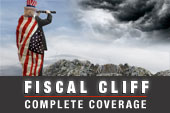New information suggests that President Obama’s ongoing drive to hike taxes on the rich may slow the economy more than expected.

In his relentless quest to make the wealthy “pay their fair share,” Mr. Obama has assumed that high earners will continue to spend no matter what. After all, even the president has acknowledged that raising taxes across the board in a recession is not good practice; it is generally believed that the huge jump in taxes during the 1930s – the top rate soared from 25 percent to 79 percent by 1936 – actually prolonged the Great Depression.
Mr. Obama seems to feel that wealthy Americans operate outside the bounds of normal economic behavior – and that making the top two percent “pay a little more” will not impact our recovery.
But what if he’s wrong? In Europe, where austerity measures have included higher taxes on the wealthy, spending at the high end has declined, impacting the producers of luxury goods in their home markets. The CEO of Burberry, which shocked investors earlier this year by cautioning a slowdown, said last month, “We knew it wasn’t Burberry specific … and it was almost overnight.” In a recent CNBC interview, Francois-Henri Pinault, the CEO of the luxury powerhouse company PPR (owner of Gucci and Yves Saint Laurent), declared, “We are in a big depression when it comes to consumption.”
Though such firms have benefited from still-strong sales to tourists from China and other emerging markets, their hometown buyers have cut back sharply. Might that happen here in the U.S.?
As was (finally) pointed out in The New York Times this week, high earners in the S will get hit with a jump in taxes next year, regardless of how the fiscal cliff is resolved. As of January 2013, the top 20 percent will be hit with an average of $6,000 in new taxes, courtesy of Obamacare. The extra charges will stem from higher taxes on wages and investment income meant to finance Medicare as well as the broader expansion of healthcare coverage to the uninsured. As The Times noted, some 85 percent of the new levies will be footed by the top one percent.
What The Times did not mention is that the wealthy are also being targeted by states attempting to plug budget holes – fiscally challenged states such as California. On Election Day, voters in the Golden State approved tax hikes amounting to $6 billion per year, of which 79 percent will be paid by the top 1 percent.
Maryland, Connecticut, Hawaii and Oregon are among other states that have raised rates for high earners in the past couple of years. As the Tax Foundation points out, we would likely have seen more such hikes except that states recognize “the taxes will negatively impact location decisions.”
The higher tax crusade by the Obama White House may already be putting a damper on spending at the high end. Steve Kraus, chief opinion officer at Ipsos, reports that his organization’s latest polling of affluent Americans showed a distinct drop in optimism. In October, facing uncertainties that included an impending Hurricane Sandy and the election, as well as higher taxes, Americans earning over $250,000 “slipped back into neutral mode” regarding their luxury spending intentions, for the first time in a couple of years.
Similarly, Gallup reports that the self-reported daily spending of upper-income Americans (defined as those making at least $90,000 per year) “was lower this November – by an average of $113 – than in any November dating back to 2008.” Apparently, according to Gallup polling, spending by high earners has trended lower for the past few months.
This is not good news. Declining incomes have strained spending by the middle class; it has been the wealthy that have carried the bulk of the consumer recovery. That’s worrisome, since high-end shoppers spend heavily on discretionary items and can easily postpone such purchases. Middle-class spenders cannot easily cut back on food and gasoline, but the wealthy can surely put off buying another pair of Prada shoes or even filling the up their carts at Costco.
Economists estimate that the top 20 percent of wage earners normally account for around 40 percent of household spending; during this period, that figure may be as high as 50 percent. Kraus says the “ultra-affluent,” those whose incomes top $250,000, account for as much as 20 percent of some high-end categories. It is that group, of course, that will be hit by Mr. Obama’s tax hike.
High-end vendors like Tiffany and Coach have fared especially well in the aftermath of the financial crisis. Most recently, Bloomberg’s retail luxury index (which compiles indications of sales activity from high-end stores like Saks) has dropped sharply – from a high of 21 at the end of August to a more recent reading at the end of November of .81.
Uncertainty about our fiscal debate and about future taxes are doubtless taking a toll. Just how much of a toll was evident in the most recent University of Michigan-Thomson Reuters consumer sentiment report, which showed that the index slumped to 74.5 from 82.7 in November. The biggest one-month drop since early 2011 was a shock; economists were expecting the index to hold roughly steady after four months of improvement.
With the recovery continuing to limp along, raising taxes on the wealthy may scratch a presidential itch, but it does little to close our deficits and – if it slows our recovery – could even worsen our budget outlook. For sure, the tax hike will not put 12 million unemployed Americans back to work.






